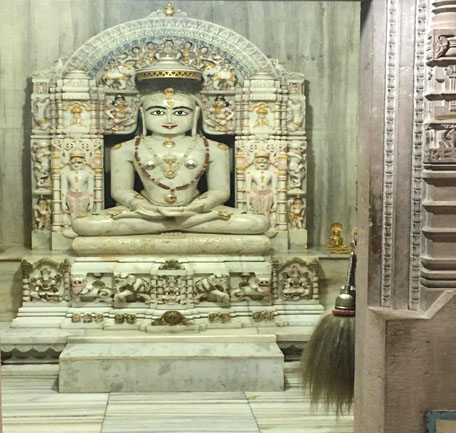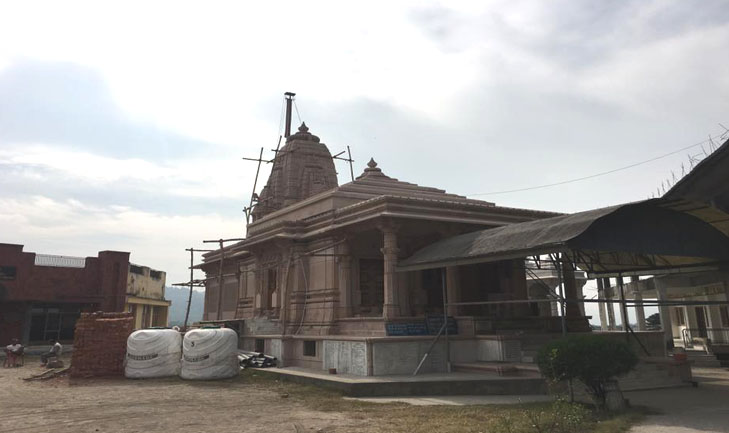Jain Tirth - Bh. Adinath
Kangra, Himachal Pradesh
 |
Author : Capt. Vimal Kumar Jain, 572, Asiad Village, New Delhi - 110049
Tele : 26493538, Mobil : 9811449431
Believed to have been established by Katoch King Susharm Chandra in the Mahabharat period, this ancient "Tirth" went into oblivion due to various circumstances. Its existence was fortunately discovered with the publication of Vigyapti Triveni (VT). VT was written in Vikram S. 1484 as a long letter by Upadhyaya Jay Sager Ji giving detail to Yatra undertaken by the Jain Sangh from Faridpur (Sindh) to Kangra. The manuscript of the travelogues was discovered by Shri jin Vijay ji at patan in 1916. It was published in a book form, titled "Vigyapti Triveni". After a long and arduous efforts, the Jain Sangh partially succeeded in reclaiming the Tirth. Jains are now allowed to perform Puja/Aarti of lord Adhinath. The idol however is in the possession of the Archaeological Department and is kept in a small shrine within the fort. An idol of Ambika, Shasan Devi of 22nd Tirthankara lord Naminath is housed in another small shrine.
Kangra is situated in the ancient "Trigart" land. The Kangra fort, also called Nagar Kot, contains the ruins of the old Jain temples and the idols mentioned above. A new temple complex has been built at the foot of the fort and has good facilities for stay of Yatris.
Introduction : Kangra, situated in the idyllic surroundings of Shivlik hills in the present day Himachal Pradesh in India was not only an important Jain Centre in the olden days but also an important place of pilgrimage for Jains from all over India. This was on account of a legendary Jain Temple dedicated to Lord Adhinath, the first Jain Tirthankara. Kangra Was dubbed as a 'Mahaterth' and won the epithet of 'Shatrunjaya of the North' it is a dark chapter of Indian history that the very existence of this important place went into oblivion. So much so that it went out of Jain consciousness itself. It was because of a number of factors, the last one perhaps was the devastating earthquake which hit the region in 1905 causing almost a complete obliteration of whatever remained of the jain temples. A miraculous survivor was the idol of lord Adinatha which in spite of its large size remained undamaged. However its existence remained unknown to the Jains till a change occurrence. This will be narrated later.
The Legend : The legend holds that during the Mahabharata war, King Susharma Chandra Katoch of Trigart desh, fought on the side of Kauravas against the Pandavas. He was responsible for launching the attack on Virat Nagar. When Kauravas got defeated, Sushrama Chandra retreated to the hiil. He built a fort and founded the city of 'Susham pur' in the 'Sapadalakash' presendoy 'shivalik' hills The fort itself was was earlier called 'Khangargarh' or Kangdak witch appears to have evolved into modern day's Kangra. Slowly the habitation around the fort also came to acquire the name Kangra instead of 'Susharmpour' or' Nagarkot'. The earliest reference to Khangargarh is available in 'Vividh Tirtha Kalpa' written by Acharya Jin Prabha Suri.
The inscription at Baijath Paprola (Keergram) temple supports the conclusion that Kangra is the new name of Susharmpur/Nagarkot.
There are some very interesting and noteworthy points in the connection. The first is the legend that the temple of lord Adinath, the first Jain Tirthanker and the fort were miraculously brought about by Goddess Ambika during the reign of King Susharma Chandra. The legend states that the King, one day, decided to abstain from all food till he had darshan of Lord Adinath at Shatrunjay, This was very far of place. Goddess Ambika, the kuldevi of Katoch King and Shashan devi of 23rd Tirthanker, lord Neminath, overnight brought about the existence of the temple dedicated to lord Adinath at the fort to save the king from certain death due to starvation as per the Jain scriptures, Lord Neminath was a contemporary and a cousin of Lord Krishna. He was about to get married to Rajimati, daughter of Raja Ugrasaen, when he decided to renounce the world.
The story goes that Krishana engineered a strategy so that Neminath chooses to renounce the world. Otherwise Neminath with his extreme strength power would have been a threat to Krishna's supremacy. It may not be out of place to mention here that account of battle between Kauravs and Pandavas in Mahabharat amply demonstrate the worldly wisdom diplomatic skill of Lord Krishana. Goddess Ambika, though common to both the Hindu and jain pantheon of goddesses, occupies an exalted position amongst the jain as the Shashan Devi of lord Neminath. Accounts of various pilgrimages to Kangra bear references to the worship of Ambika along - with the worship at the temple of Adinath at the fort. Incidentally, the oldest extent idol of Ambika is understood to be a jain idol.
The Fort : The Fort is built on a narrow strip of a hill feature at the confluence of two rivers, Ban Ganga and Manjhi (also called Patel Ganga) the hill has sides, with a sheer drop of about 400 fits to the riverbed. The Kangra Township lies to the Northeast. The hill feature on which the fort is located is connected to the township by an isthmus about 50m wide. The topography imparts role in the long uninterrupted rule of Katoch King in the area down to the medieval times. Presently, the fort contains only scattered ruins of the jain temples and a surprisingly intact large jain idol of Lord Adinath. The idol is carved in dark gray stone with locks of hair falling on shoulders on either side. Its size is (39.5x31x17.5) with symbol of the "bull" engraved on the seat. This large idol appears to have been the presiding deity in the surrounding areas till at least the attack of Mahmud Ghazni in 1009 AD and probably till much later. Till the devastating earthquake of 1905 witch caused considerable havoc, the fort form 1909 AD onward had a long history of wars and occupation by various garrisons of the Muslims, Gurkhas, Mughal, Sikh and finally the British. The various building and temples inside the fort saw many misadventures by the 'occupation forces'. The entire fort was declared a "protected monument" by the then Punjab Government in 1909*
Jain history of Kangra : For many centuries till the twentieth the jain connection with Kangra remained a forgotten chepter of history. In 1872-73, Sir Alexander Cunningham was first to notice the remains of old Jain temple in the Kangra fort and in Kangra town. Although some of his observations show his inadequate familiarity with jain tradition, but the details mentioned by him are sufficient to show a significant presence of jain ruins both in the the fort as well as the town ship. But in sprite of sir cunningham's discovery in 1872-73 and later reports by Buhlar other the jain connection of Kangra remained almost unknow in the Jain consciousness till a change discovery of a manuscript called "Vijnapti Triveni" by Muni Jin Vijaya during his studies at paten. Vijnapati Triveni is a travelogue of pilgrimage undertaken in VS 1484 (1427 AD), from Faridpur in Sindh to Nagarkot (Kangra) and back. Vijanpati are usually the accounts of activities of the monks during their various sojourns undertaken at the behest of their guru. The term is also applied to the formal request by Jain Shravak Sanghs to their guru praying him to come for Chaturmas to their place to direct all the religious activities during that period. Quite often such vijnaptis were long, poetic, illustrated and containing many details of the local area and people as well as information of surrounding area. The historians especially the jain historians will forever remain grateful to Muni Jin Vijay ji for having done a sterling service by publishing the contents of Vijanpati Triveni in 1916 AD and thus bringing to life a forgotten chapter of Jain history. It also underlines the importance of examining the vast reservoir of jain manuscripts, which may reveal new facts about Indian history. About Kanga, Sahitya Vachaspati Bhanwarlal Nahata did further study and research this contained a summary of various reference to Kangra in Jain literature as well as a compilation of various compositions on Kangra Mahateerath by various Jain monks and shravaks who went to Kangra on pilgrimage during the years 1391-1634.
Conclusion : From the above it is clear that Kangra was an important center of pilgrimage for Jains and was considered as a Mahatirth. Cunningham, Buhlar, Dr. K. N. Seetharam have all discovered wide spread Jain ruins in the area, which corroborates the prominence of Jain shrines described in the various travelogues. There is no doubt that katoch dynasty had a number of king who were follower of Jainism and a few more who patronized it. This show that there is an urgent need for detailed research in to old history of Kangra. Phone: 01892-265187
 |
-----------------------------------------------------
Mail to : Ahimsa Foundation
www.jainsamaj.org
R051004